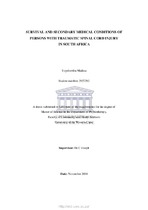| dc.description.abstract | Background: A spinal cord injury (SCI) results in a change, either temporary or permanent,
in the cord’s normal motor, sensory or autonomic function. In addition, secondary medical
complications are common, following an SCI. As such, mortality risk in the spinal cord
community remains higher, when compared to the general population. Understanding the
complexity of factors related to mortality, remains paramount.
Aim: The overarching aim was to assess mortality and secondary medical complications, four
years after traumatic spinal cord injury (TSCI) in the City of Cape Town, South Africa.
Secondarily, factors associated with mortality and the development of secondary medical
complications were assessed.
Methods: A prospective, population-based design was used. The study population consisted
of all respondents with TSCI, who were enrolled in an earlier incidence study that was
conducted in 2013/2014. For this follow-up study, an inclusive sampling strategy was used.
All eligible respondents (N=145), or a family member of the deceased, were initially
telephonically contacted and requested to complete a valid and reliable interview-administered
questionnaire, to be completed face-to-face, or telephonically. Of those patients who were
deceased, a close family member, or former caretaker was asked to participate in this current
study. In order to aid the generalisability of the findings to the immediate source population,
every non-responder with information available from baseline data collected in 2013/2014,
were accounted for. Descriptive statistics were used to describe the cohort and to present the
mortality rate, as well as point-prevalence of secondary medical complications. Inferential
statistics, namely, bivariate logistic regression analysis, were used to identify factors associated
with mortality and the development of secondary medical complications. | en_US |

